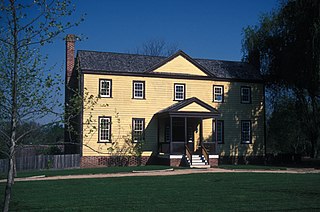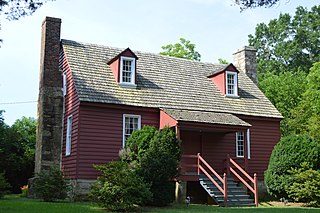
McDowell County is a county located in the U.S. state of North Carolina. As of the 2020 census, the population was 44,578. Its county seat is Marion.

Burke County is a county located in the U.S. state of North Carolina. As of the 2020 census, its population was 87,570. Its county seat is Morganton.

Falls Lake State Recreation Area is a North Carolina state park in Durham and Wake counties, North Carolina in the United States. Near Wake Forest, North Carolina, it covers 5,035 acres (20.38 km2) along the shores of 12,410-acre (50.2 km2) Falls Lake.

This is a list of structures, sites, districts, and objects on the National Register of Historic Places in North Carolina:

The Linville Gorge Wilderness is the third largest wilderness area in North Carolina and one of only two wilderness gorges in the Southern United States. Maintained by the United States Forest Service, it comprises 11,786 acres (47.70 km2) around the Linville River, and is situated inside the Pisgah National Forest. The river is approximately 1,400 feet (430 m) below the ridge, thus hiking in and out of the Gorge is challenging and enjoyable for those who like serious hiking. The plant and animal community is extremely diverse, with a dense hardwood/pine forest and a wide variety of smaller trees and other plants as well as bear, fox, raccoon, trout, grouse, wild turkey, vultures, owls, hawks, copperheads, and timber rattlesnakes.

The Linville River is a river in western North Carolina, United States. The river begins in the slopes of Peak Mountain, Sugar Mountain and Flattop Mountain, in the Linville Gap area. As it goes south through Avery County, it passes through the communities of Grandfather, Linville, Pineola, Crossnore and finally at Linville Falls. After entering Burke County at the community of Linville Falls, the river becomes the centerpiece of the Linville Falls and the Linville Gorge, an area referred to as "the Grand Canyon of North Carolina." After approximately 30 miles (48 km), the river ends at Lake James and the Catawba River; the original confluence with the Catawba River has been flooded by the creation of the reservoir in 1923.

Linville is an unincorporated community and census-designated place (CDP) in Avery County, North Carolina, United States. It was first listed as a CDP in the 2020 census with a population of 283. Centered just south of US 221 and NC 105, the community is known as a summer mountain resort and host of the Grandfather Mountain Highland Games, the largest modern Highland games events in North Carolina.

Union Tavern is a historic tavern and workshop on Broad Street in Milton, North Carolina. It is a rare example of a well-preserved early 19th-century Federal period tavern, and is further notable as the workshop of Thomas Day, a free person of color who was one of North Carolina's leading cabinetmakers. The building was designated a National Historic Landmark in 1975. It is located in the Milton Historic District.

Falls, is an unincorporated community in Wake County, North Carolina, United States, situated on Old Falls of Neuse Road, between Raleigh and Wake Forest, near the Wakefield Plantation development. Falls Dam, on the Neuse River, is within the community.

Linville Falls is an unincorporated community located at the junction of Avery, Burke, and McDowell counties in the U.S. state of North Carolina. It is named after Linville Falls, a nearby waterfall in the Linville Gorge Wilderness.

Brooklandville House, or the Valley Inn, is a historic restaurant and tavern building, and a former inn, located in Brooklandville, Baltimore County, Maryland. It is a 2+1⁄2-story stone structure facing the former railroad and dating from about 1832. It is associated with the Baltimore and Susquehanna Railroad, which crossed the property just to the south.

Whitney Mansion is a historic home located at Niagara Falls in Niagara County, New York. It is a two-story Greek Revival stone structure built in 1849 by the son of General Parkhurst Whitney, a village founder and owner of the Cataract House and The Eagle Tavern. The structure features a two-story pedimented porch with four heavy Ionic columns. It is located overlooking the Niagara River, just above the American Falls. It now contains law offices.
Altamont is an unincorporated community in Avery County, North Carolina, United States. The community is located along US 221/NC 194, between the town of Crossnore and the community of Linville Falls. Altamont translates to "High Mountain."

Linville is a Census-designated place located in Rockingham County, in the U.S. state of Virginia. It is located 6 miles north of Harrisonburg, Virginia. It is for the first time listed as CDP for the United States Census 2020. It contains the Linville United Church of Christ.

Linville Historic District is a historic school campus and national historic district located at Linville, Avery County, North Carolina. It encompasses 96 contributing buildings and 4 contributing structures in the historic core of Linville. The buildings date between about 1892 and 1940, and include shingle-or chestnut bark-covered resort buildings and the second generation of houses flanking the first and eighteenth fairways of the golf course. Notable buildings include the Hemlock Cottage, Dormiecroft, "Honeymoon" Cottage, Presbyterian Church, The Studio, the VanLandingham House, and All Saints Episcopal Church.

The Newichawannock Canal is a man-made canal which drains Great East Lake into Horn Pond at the border between Wakefield, New Hampshire, and Acton, Maine, in the northeastern United States. It is at the head of the Salmon Falls River, which the Abenaki called Newichawannock, meaning "river with many falls". Begun in 1850 by the Great Falls Company to increase the water available for its mills in Somersworth, New Hampshire, the 0.75-mile (1.21 km) canal is unusual as it was built for strictly industrial purposes in an area remote from the actual industrial site. The canal forms the boundary between the states of New Hampshire and Maine, and is spanned by a stone bridge built at the same time. The canal and bridge, along with related artifacts, were listed on the National Register of Historic Places in 2014.

The Eagle Tavern is a historic tavern built in the 1790s in Halifax, Halifax County, North Carolina. The tavern served as an overnight stop for the official traveling party during the visit of the Marquis de Lafayette to the United States. The tavern is demarcated as "E-68" on the North Carolina Highway Historical Marker Program. It is a two-story, pedimented, T-shaped tripartite frame building. It was moved to its present site in the 1970s from its previous location next to the Church of the Immaculate Conception at 145 South King Street in Halifax. Both the Eagle Tavern and the Church of the Immaculate Conception were owned at that time by descendants of Michael Ferrall.

Franklin-Penland House, also known as Theodore C. Franklin House, Stokes Penland House, and Linville Falls Post Office, is a historic home located at Linville Falls, Burke County, North Carolina. It was built about 1883, and is a two-story, three-bay, frame I-house with a two-story rear ell. It features a full-width, attached two-tiered shed roof porch added about 1915. Also on the property is the former U.S. Post Office, Linville Falls, N.C., building. The one-room front gable frame building was built in 1907 and housed the Linville Falls post office until 1925.

Person's Ordinary is a historic inn and tavern located at Littleton, Halifax County, North Carolina. It dates to the mid- to late-18th century, and is a 1 1/2-story frame dwelling, three bays wide and two deep, with a massive exterior stone chimney at each end. It rests on a stone cellar, and has a modified Quaker plan. The building housed an inn and tavern for stagecoach travelers into the 1830s and is associated with Thomas Person, one of the state's most important political leaders from 1760 to 1790.

Falls of the Neuse Manufacturing Company, also known as the Manteo Manufacturing Company and Forest Manufacturing Company, is a historic paper mill complex located at Falls, Wake County, North Carolina. The main mill building was built from1854–1855, and is a three-story, quarried granite block building measuring 195 feet long and 54 feet wide. Located on the property is the stone mill dam, measuring about 400 feet wide and roughly 6 feet tall, and the one-story picker room, measuring 53 feet square. The mill operated as a paper mill until 1896, and later housed a cotton mill and warehouse.























